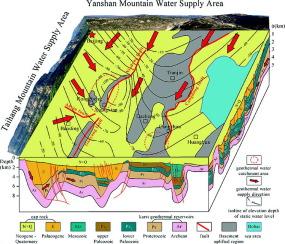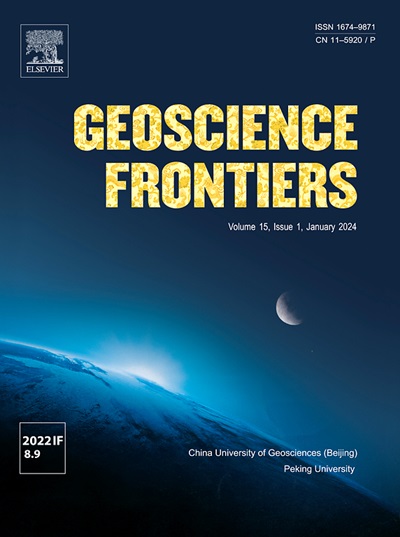京津冀平原岩溶地热储层地热流体运移特征
IF 8.9
1区 地球科学
Q1 GEOSCIENCES, MULTIDISCIPLINARY
引用次数: 0
摘要
京津冀平原是中国中深层地热采暖规模最大、发展最快的地区之一。本文通过对河北省7个地热田、河南省2个地热田、山东省2个地热田的82份地热流体样品的测试,结合北京、天津地区岩溶地热水化学特征的研究,系统分析了京津冀平原岩溶地热储层中地热流体的运移特征。研究区岩溶地热水水化学特征存在一定差异。河北地热水相对于周边省份较为成熟。区内总溶解固形物(TDS)和锶元素的分布呈现南北低、中部高的特征,表明地热流体的总体流动方向是由南北走向中部。结合地下水流场和地热井水化学特征沿地质剖面的变化趋势,建立了地热水运移模型。源自太行山、燕山和鲁西山的地热流体进入盆地,并沿输水断裂向盆地中部继续运移。然而,同一供给方向的地热流体运移特征并不完全相同。太行山地热流体北被牛洞断裂切断,终止于冀中坳陷中央隆起带,南沿衡水转换带进入冀中坳陷东部相对较快。燕山地热流体沿沧东断裂向盆地内运移,同时也破坏了构造单元间的水力连接。考虑有效动态条件,建议在雄县周边和沧州市西南部地热水集水区进一步扩大地热能科学开发利用规模。本文章由计算机程序翻译,如有差异,请以英文原文为准。

Migration characteristics of geothermal fluids in karst geothermal reservoirs in the Beijing-Tianjin-Hebei Plain
The Beijing-Tianjin-Hebei Plain is among the regions in China that feature the largest scale and the fastest growth in medium and deep geothermal heating. Based on tests of 82 geothermal fluid samples from 7 geothermal fields in Hebei Province, 2 geothermal fields in Henan Province, and 2 geothermal fields in Shandong Province, and combined with previous studies on the chemical characteristics of karst geothermal water in Beijing and Tianjin, this paper systematically analyzes the migration characteristics of geothermal fluids in karst geothermal reservoirs within the Beijing-Tianjin-Hebei Plain. The hydrochemical characteristics of karst geothermal water in the research areas exhibit certain differences. The geothermal water in Hebei is more mature than that in its neighboring provinces. The distribution of total dissolved solids (TDS) and strontium elements in the area is characterized by being low in the north and south and high in the middle, suggesting that the overall flow direction of geothermal fluid is from the north and south towards the middle. Combined with the groundwater flow field and the changing trend of the hydrochemical characteristics of geothermal wells along the geological section, a geothermal water migration model has been established. The geothermal fluids originating from Taihang Mountain, Yanshan Mountain, and Western Shandong Mountain enter the basin and continue to migrate towards the central part of the basin along water-conducting faults. However, the migration characteristics of geothermal fluids with the same supply direction are not identical. The geothermal fluids from Taihang Mountain are cut off by the Niudong Fault in the north and terminate in the central uplift belt of the Jizhong Depression, while in the south, they enter the east of the Jizhong Depression relatively quickly along the Hengshui Conversion Belt. The geothermal fluids from Yanshan Mountain migrate into the basin along the Cangdong Fault, yet this fault also disrupts the hydraulic connection between the tectonic units. Considering the effective dynamic conditions, it is recommended to further expand the scale of the scientific development and utilization of geothermal energy in the geothermal water catchment areas around Xiongxian County and southwest Cangzhou City.
求助全文
通过发布文献求助,成功后即可免费获取论文全文。
去求助
来源期刊

Geoscience frontiers
Earth and Planetary Sciences-General Earth and Planetary Sciences
CiteScore
17.80
自引率
3.40%
发文量
147
审稿时长
35 days
期刊介绍:
Geoscience Frontiers (GSF) is the Journal of China University of Geosciences (Beijing) and Peking University. It publishes peer-reviewed research articles and reviews in interdisciplinary fields of Earth and Planetary Sciences. GSF covers various research areas including petrology and geochemistry, lithospheric architecture and mantle dynamics, global tectonics, economic geology and fuel exploration, geophysics, stratigraphy and paleontology, environmental and engineering geology, astrogeology, and the nexus of resources-energy-emissions-climate under Sustainable Development Goals. The journal aims to bridge innovative, provocative, and challenging concepts and models in these fields, providing insights on correlations and evolution.
 求助内容:
求助内容: 应助结果提醒方式:
应助结果提醒方式:


